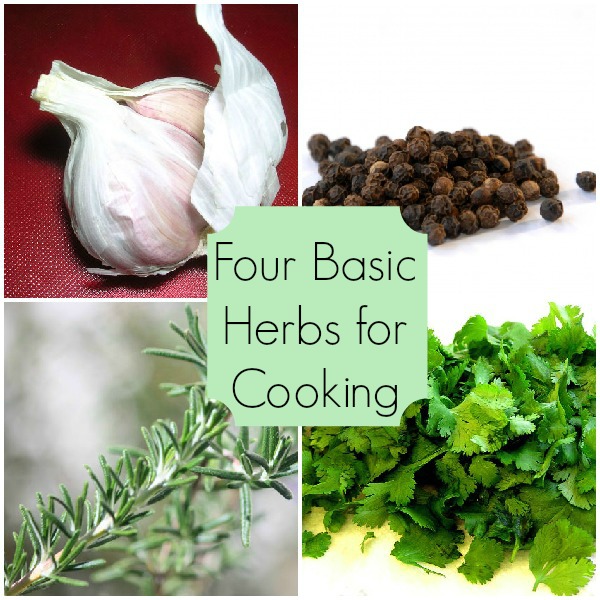Since I know nothing about cooking, I turned to an expert to give me tips on the best herbs for cooking. Enjoy her post!
Throughout the ages, people have used herbs to make their food more palatable. It has only been comparatively recently that people have used artificially produced chemicals and refined sugars in their food. But studies are now showing that old fashioned, tried and true, natural ingredients are so much better for us than artificial chemicals. Getting your flavor zing naturally will be much better for your health in the long run, because natural ingredients work with your body, not against it. They also come paired with important nutrients like antioxidants, minerals, vitamins, oils, proteins, and fiber. Using herbs for flavoring is a win-win option. Here is a look at some of the more widely used herbs for cooking.
Garlic
Garlic is a commonly used ingredient in main dishes. It is widely used throughout the world, including in Italian, Mexican, Mediterranean, European, and North American cuisine. Recipes that include garlic often call for it to be minced or crushed, although whole cloves are sometimes used. To use garlic, remove the papery outer covering. Remove the desired number of cloves from the bunch. Once they are peeled and the ends are removed, you can use the cloves in the recipe. Garlic offers benefits for heart and circulatory health as well as anti-microbial properties and nutrients that enhance immunity and recovery from colds and other illnesses.
It’s a good idea to try to incorporate garlic into your entres on a frequent basis. One thing that makes using garlic really easy is a garlic press. Instead of having to peel each clove and mince it, you simply put a clove in the press, unpeeled, and squeeze. It takes about one minute to press five or six cloves. You can get a good quality garlic press for $10-$15.
Peppercorns
Black pepper is known as the “king of spice.” Pepper contains a variety of compounds that have health promoting and disease preventing properties. It has historically been used as an anti-inflammatory. It also may help to increase the body’s absorption of selenium, beta-carotene, B vitamins, and other nutrients in food. Black peppercorns also contain potassium, zinc, calcium, manganese, iron, magnesium, vitamin C, vitamin A and other important nutrients.
Black pepper from the store comes from grinding black peppercorns. Using a peppercorn grinder, you can grind your own peppercorns as needed, and even use the grinder at the dinner table in place of a pepper shaker. Freshly ground peppercorns are generally more flavorful than pepper that has been ground, packaged, shipped, and sitting on a grocery store shelf for months.
Rosemary
Rosemary is a tasty herb that is a basic for preparing poultry dishes. It is also pairs nicely with garlic in sautéed vegetables and in sauces. Grinding the dried leaves with a peppercorn grinder can help the flavor diffuse into the food more effectively. It can also break the leaves into smaller pieces so that the texture doesn’t take away from the palatability of the food.
Rosemary also contains compounds known to inhibit cancer growth. It has been used to relieve pain, reduce inflammation, boost immunity, cure migraine headaches, elevate mood, improve blood circulation, detoxify the liver, and improve memory, in addition to many other things. It is also used in aromatic products.
Cilantro
Cilantro is an herb with a distinctive, unique taste that produces a mouth-watering, more-ish effect. One of the most common foods to encounter cilantro in is fresh Mexican salsa. However, it has historically been used in many places around the world. For instance cilantro essential oils were used in perfumes in Ancient Greece. Cilantro was also used to cover up the smell of bad meat in the medieval Roman civilization.
Cilantro is easy to grow and easy to use. It has a short growth cycle of just a few weeks. It’s easy to raise in indoor planting boxes or in outdoor gardens, and it takes very little space. To keep fresh cilantro ready for use on a continual basis, plant new seeds every 3 weeks or so. Once the leaves are ready for harvest use them fresh (without freezing or drying). You can cut them into small pieces and add them to the food using kitchen shears or a knife and cutting board.
Cilantro has strong anti-diabetic properties. In fact research suggests that using it in cuisine on a regular basis may be a remedy for diabetes. In addition, it has strong antioxidant activity, as well as anti-infammatory properties, antifungal and antibacterial activity, and is a source of several trace minerals and vitamins.
Conclusion
If you haven’t already discovered the joy and health benefits of cooking with herbs, it’s time to start. Let your tongue get its flavor fix with beneficial herbs instead of harmful synthetic chemicals and refined sugars.
Lauren Hill is a contributing author for The Growers Exchange, an online gardening company offering potted plants and accessories for your herb garden.



